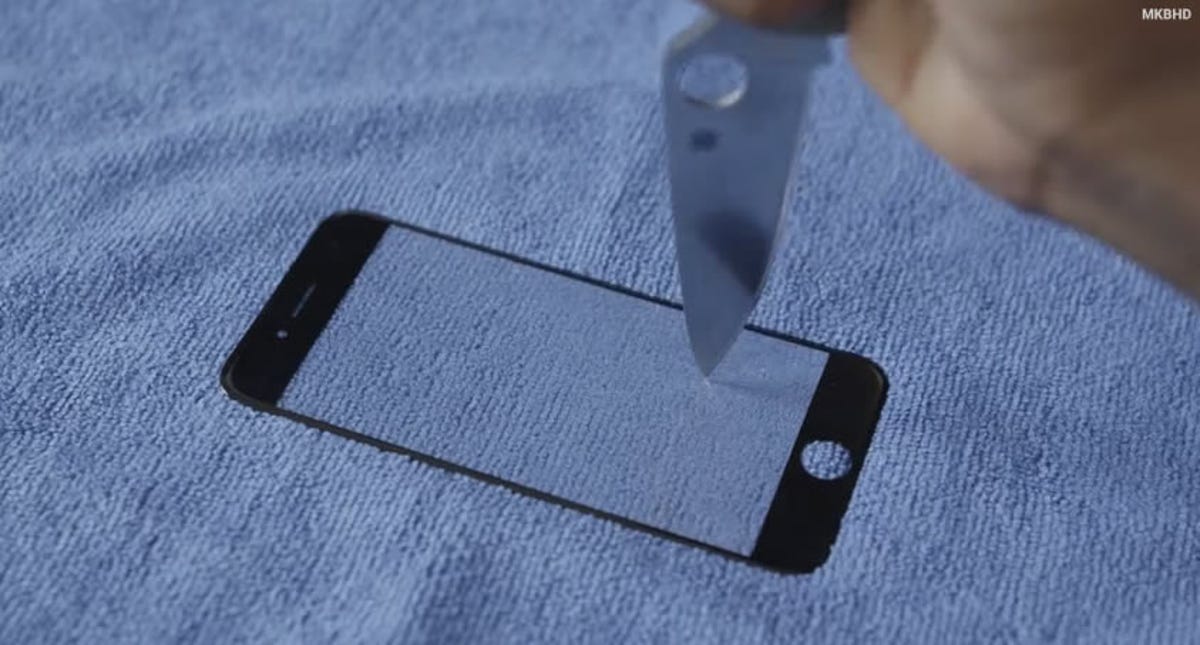
Marques Brownlee/YouTube/screenshot by Lance Whitney/CNET
Repeated rumors have suggested that the iPhone 6 will sport a sapphire-glass screen, but some analysts are throwing cold water on that idea.
In a report released Monday, LEDinside analysts from market researcher Trendforce said they have yet to see the necessary orders for sapphire glass wending their way through the supply chain in time to meet an expected September launch for a 4.7-inch iPhone 6. A new iPhone with sapphire glass could still roll out in limited numbers, they noted.
Would the lack of a sapphire screen put a dent in sales of a new iPhone? Not likely, though the uber-hard material could be a key selling point.
Considered the third-hardest mineral, sapphire creates glass that is difficult to break and extremely scratch resistant. Sapphire glass proponents say it is is tougher than the Gorilla Glass currently used for iPhone screens, though Corning would beg to differ. Because of its hardness, though, the synthetic sapphire for the glass is difficult and expensive to produce and cut into the right shapes — a challenge when it comes to mass production. Sapphire is already used to make the iPhone’s camera lens and the cover of the Touch ID sensor found on the iPhone 5S, but those are relatively small areas.
In their report, the analysts explained their pessimism over a large-scale rollout of sapphire-screened iPhones in time for September:
The sapphire material is still being applied in new generation Apple smartphones camera lenses and fingerprint recognition readers. If the new iPhone keeps up Apple’s previous smartphone models hot selling records, sapphire demands will be driven by the smartphone’s applications till the end of this year. However, the much anticipated sapphire cover glass remains missing from the picture. Analysis of the iPhone 6 supply chain indicates related component suppliers need to ship products to OEMs for assembly in June 2014 to meet the September launch date. Yet, the research institute did not discover demands for smartphone cover glass. The sapphire glass version new iPhone will be issued in limited volumes this year, mostly because sapphire ingot manufacturers yield rates were lower than forecasts and issues involved in sapphire glass processing.
The analysts said they still have a positive outlook for sapphire pricing and demand for the second half of 2014. That means a new batch of sapphire substrate orders could arise later if iPhone 6 sales take off.
Even Apple’s much-rumored iWatch may not be immune from certain challenges in adopting sapphire glass. According to one analyst, mass producing sapphire glass for a 2.5-inch smartwatch cover would be “problematic.” Further, the process would be even more difficult if the iWatch attempts to use flexible OLED panels.
Hutch Hutchison, head of design and concept creation at British manufacturer Vertu, explained to UK newspaper The Guardian the pros and the cons of adopting sapphire glass in a mobile phone.
“Sapphire crystal is an incredibly tough, high quality material and this makes it perfect for luxury mobile phone screens,” Hutchison told the Guardian. “It is virtually impossible to damage and it will maintain a perfect, scratch free finish for many years. It can take two weeks to grow each boule (a cylindrical stick in which sapphire glass is grown) and the yield from each is low. It is also very difficult to cut, grind, and polish; diamond tools have to be used for all of these processes.”



